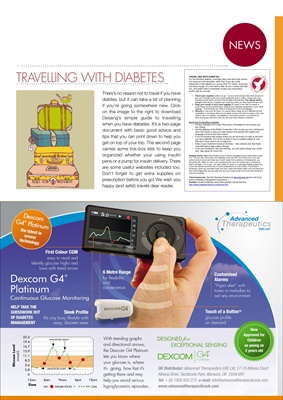
NEWS
TRAVELLING WITH DIABETES
For the traveling diabetic, overnight stays and short trips should
not cause any real anxieties, other than if you are newly
diagnosed or the diabetic is a young child. For adults, short trips
are easy enough. You will need to take all your normal stuff with
you, and might need to remember to take your long-acting
insulin with you as well.
1. Check your supplies before you go - do you have enough blood test sensors to
last you? Enough insulin and a hypo treatment (just in case). Longer trips and
overseas travel need a bit more fore-thought and planning. Two weeks' before
you go check all your supplies and to get any extra you may need from your GP.
2. Keep your insulin in your hand luggage (If it goes in the hold of a plane it
could freeze and be deactivated). Keep all your diabetes equipment in your hand
luggage - the last thing you need is it being part of any lost luggage.
3. Security is now such an issue, it's a good idea to keep all your diabetes kit and
medication in one place that you can easily access and show to anyone who may
need to see it at customs. As diabetes is now quite common, you should not
have real issues with this in the UK, US and many Western countries.
Some tips for traveling overseas:
□ Contact Diabetes UK to see if they have a factsheet on the country you
are visiting.
□ Get the address of the British Consulate in the country you are visiting and
have that handy in case you need advice from people who speak your
language but know the local culture.
□ If you're traveling with people whom you do not know it is wise to tell them
you have diabetes. It's not fair on them if you're suddenly taken ill, and
they don't know what to do to help you!
□ Keep a hypo treatment handy at all times - new cultures and new foods
may well lead to high sugars, though.
□ If you are traveling to very hot climates, you will need to keep your insulin
cool. See below for more info.
Keeping insulin cool: Each bottle or box of insulin cartridges has an information sheet
in it. You can also check with your diabetes nurse and GP, but in the main if you use
some common sense and keep your insulin away from extremes of temperature, you
should be OK. When it's not in use (unopened and not in an insulin pen), it should be
kept in a fridge. If it's in use - an open bottle of insulin or a cartridge already loaded into
a pen, the insulin should be fine at room temperature for a few weeks. If you think it
necessary, there are specialist bags and carry cases that keep insulin cool and there are
even mini-fridges that you can plug into the car to keep insulin cool if you are traveling in
very hot countries.
Travel resources: See the Desang Directory at www.desang.net for a list of all
sorts of diabetes management equipment. *
Another excellent diabetes and travel website can be found at
http://www.diabetes-travel.co.uk/home.htm
TRAVELLING WITH DIABETES
There's no reason not to travel if you have
diabtes, but it can take a bit of planning
if you're going somewhere new. Click
on the image to the right to download
Desang's simple guide to travelling
when you have diabetes. It's a two-page
document with basic good advice and
tips that you can print down to help you
get on top of your trip. The second page
carries some tick-box lists to keep you
organized whether your using insulin
pens or a pump for insulin delivery. There
are some useful websites included too.
Don't forget to get extra supplies on
prescription before you go! We wish you
happy (and safe!) travels dear reader.